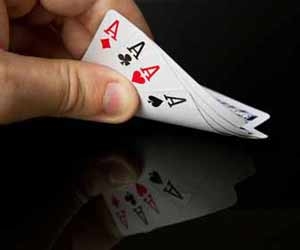Casino Blackjack
The card game of blackjack, also known as twenty-one, is commonly believed to have grown out of the popular French game vingt-et-un. Early nineteenth-century professional gamblers are credited with bringing blackjack, as well as many other parlor games, into gaming’s mainstream by eliminating its air of European elitism. As a result, the game quickly became popular in the United States, especially with those who were out to tame the West.

Today, blackjack is a staple of casino gambling and has replaced craps as America’s favorite casino table game.
In most casinos blackjack tables are interspersed with craps, roulette, and other specialty game tables arranged in an oval or rectangle around the pit – the enclosed area behind the tables where the imposing pit bosses or supervisors stand. Some of the larger, newer casinos offer elongated pits with a seemingly endless number of blackjack tables. The dealer stands behind the half-oval-shaped table and faces up to seven players. The seat farthest to the left of the dealer is known as “first base,” while the seat farthest to the right is “third base,” the prime seat for card counters. Contrary to popular belief, counting cards is not illegal; however, it is frowned upon by casinos. Suspected card counters usually are asked to leave the casino. Beat the Dealer by Edward O. Thorp, published in the early 1960s, started the current trend of blackjack strategy books. Before Thorp’s book, the odds in blackjack were heavily against the player. After it became widely read and its strategies disseminated, savvy players saw huge wins and casinos began to worry about their profit margins. In order to compensate, house rules changed, putting the odds back into the casinos’ favor. One example of such a variation was the introduction of multiple decks dealt from wooden or plastic racks, called shoes, instead of from the dealer’s hand. You should expect the rules of blackjack to vary slightly from casino to casino and city to city.
The object of blackjack is to beat the dealer’s hand without going over twenty-one (“busting”).
Depending upon casino rules, the dealer must “hit” (to draw another card) on card hands totaling sixteen and below, and “stand” (stay with the hand) on totals of seventeen or higher.
Players, however, have numerous options. If a player’s first two cards total twenty-one and the dealer’s upcard is two through nine, then the player automatically wins. Otherwise, the player may either stand – motioned by waving his palm over the cards if the cards are face up, or pushing the cards under the bet if they are face down – or hit – motioned by pointing his index finger at the cards if they are up, or scraping the cards on the felt towards himself if they are face down. Gestures versus words are more practical since most casinos are too noisy for the dealer to always hear players’ directions.
Other options for hitting include “doubling down” and “splitting.” Doubling down occurs when a player feels so secure about the next card that he is willing to bet double his original bet. The dealer then deals only one more card to the player. Splitting works as an option only when a player has two cards of equal rank or numerical value (two kings, two fives). The player then turns both cards face up, if they are not so already, and adds another bet equal to the amount of the original bet. He is now playing two hands and can double down, stand, hit, or split again on either hand, according to casino rules. The dealer plays last by turning over and playing her hand.
Generally, players tip the dealer right before leaving the table. Although often, through exuberant goodwill, players will tip the dealer after a winning hand. However, the most profitable toke is when a player places a bet for the dealer. This can be done in two ways: Chips can be placed outside of the betting box or inside the box directly alongside the player’s own bet. In the former method the dealer gets double the tip in a winning hand. Many casinos require the dealer to take it immediately after the hand, however, which means that the player has to make another bet if he wants to tip the dealer in the next round. In the latter method the dealer can make a tremendous amount of money, if the player hits a streak of perfect cards and lets the tip ride.

